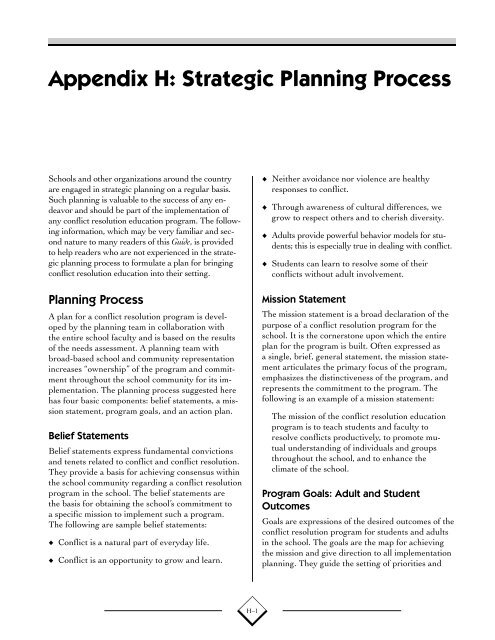Conflict Resolution Education - National Criminal Justice Reference ...
Conflict Resolution Education - National Criminal Justice Reference ...
Conflict Resolution Education - National Criminal Justice Reference ...
Create successful ePaper yourself
Turn your PDF publications into a flip-book with our unique Google optimized e-Paper software.
Appendix H: Strategic Planning Process<br />
Schools and other organizations around the country<br />
are engaged in strategic planning on a regular basis.<br />
Such planning is valuable to the success of any endeavor<br />
and should be part of the implementation of<br />
any conflict resolution education program. The following<br />
information, which may be very familiar and second<br />
nature to many readers of this Guide, is provided<br />
to help readers who are not experienced in the strategic<br />
planning process to formulate a plan for bringing<br />
conflict resolution education into their setting.<br />
Planning Process<br />
A plan for a conflict resolution program is developed<br />
by the planning team in collaboration with<br />
the entire school faculty and is based on the results<br />
of the needs assessment. A planning team with<br />
broad-based school and community representation<br />
increases “ownership” of the program and commitment<br />
throughout the school community for its implementation.<br />
The planning process suggested here<br />
has four basic components: belief statements, a mission<br />
statement, program goals, and an action plan.<br />
Belief Statements<br />
Belief statements express fundamental convictions<br />
and tenets related to conflict and conflict resolution.<br />
They provide a basis for achieving consensus within<br />
the school community regarding a conflict resolution<br />
program in the school. The belief statements are<br />
the basis for obtaining the school’s commitment to<br />
a specific mission to implement such a program.<br />
The following are sample belief statements:<br />
♦ <strong>Conflict</strong> is a natural part of everyday life.<br />
♦ <strong>Conflict</strong> is an opportunity to grow and learn.<br />
H–1<br />
♦ Neither avoidance nor violence are healthy<br />
responses to conflict.<br />
♦ Through awareness of cultural differences, we<br />
grow to respect others and to cherish diversity.<br />
♦ Adults provide powerful behavior models for students;<br />
this is especially true in dealing with conflict.<br />
♦ Students can learn to resolve some of their<br />
conflicts without adult involvement.<br />
Mission Statement<br />
The mission statement is a broad declaration of the<br />
purpose of a conflict resolution program for the<br />
school. It is the cornerstone upon which the entire<br />
plan for the program is built. Often expressed as<br />
a single, brief, general statement, the mission statement<br />
articulates the primary focus of the program,<br />
emphasizes the distinctiveness of the program, and<br />
represents the commitment to the program. The<br />
following is an example of a mission statement:<br />
The mission of the conflict resolution education<br />
program is to teach students and faculty to<br />
resolve conflicts productively, to promote mutual<br />
understanding of individuals and groups<br />
throughout the school, and to enhance the<br />
climate of the school.<br />
Program Goals: Adult and Student<br />
Outcomes<br />
Goals are expressions of the desired outcomes of the<br />
conflict resolution program for students and adults<br />
in the school. The goals are the map for achieving<br />
the mission and give direction to all implementation<br />
planning. They guide the setting of priorities and

















